
swedish birthrate data: november update
rates remain severely depressed and the associations on cause are provocative
sweden’s birth rate data remains severely suppressed in a fashion unprecedented in the 25 years of data to which i have access. double digit percentage drops in natality constitute a severe demographic issue and one might think that such a jarring outcome might be eliciting widespread and urgent curiosity as to cause. yet oddly, it is not. i fear this may have to do with what looks to be the most plausible culprit. once more it would seem that health agencies are failing to look for that which they would be horrified to find.
some base priors here:
correlation is not causality. these associations are not and cannot be positive proof. but they can certainly be cause for suspicion and alarm.
such suspicion is greatly bolstered by strong, independent, and a priori reasons to suspect fertility effects from covid vaccines as they are known to collect in testes and ovaries and the ability of mRNA drugs to trigger ongoing auto-immune issues is well known.
we have specific clinical studies that show not only sharp suppression in sperm total motile counts post covid vaccination, but that appear to show that something on the order of 20% of subjects are not recovering from this and may be experiencing near total loss of motility. effects on eggs and ovaries seem less well studied (itself a somewhat puzzling outcome) but could be similar or perhaps worse as eggs, once damaged, are gone and do not regenerate.
so, we’re not just seeking out seeming or spurious correlation here. we have sound reason to suspect an effect rooted in demonstrated clinical biology and are looking at society scale data to see if it is manifesting. that is a much higher quality form of evidence than pure associative data mining. it is still not “proof” in the sense of RCT or being able to look at births by vaccine status and seek curve separation between the two cohorts, but it is not a result to readily dismiss or hand wave away either. especially as the period of “this might be an echo from everyone going travelling in summer 2021” per my attempts at “testable hypotheses” from back in july 2022 has now passed without any improvement, this looks to me to be reaching the point of having to be accepted as the odds on best theory.
OK, so let’s look at the data: (all data from SCB.SE)
this is the base births data divided by current population (provided in same dataset by month) to normalize to birth per million population.
births are highly seasonal, so the easiest way to see divergence is to compare years to years by stacking curves.
as can be readily seen, 2022 is a strong divergence from the prior 3 years (as far back as the months data goes.
the size of this drop can be more readily seen by plotting % change from prior year.
clearly, this is quite sharp and (so far) durable.
this data is a bit short term, so i zoomed out to full year change vs prior year because FY data exists back to 1998. i have estimated 2022 by comparing it to the past 3 years. % of births in a year per month are remarkable stable. % of births in first 11 months of the year were 93%, 92.9%, 92.9% in 2019, 20, 21 respectively. this averages to 92.9% and can be used to estimate FY 2022 with high expected accuracy. (shown in red)
we get this:
the pre 2022 STD deviation in this series is 2.1%. the values seem distributed in a bell curve. this implies that (assuming the last 25 years are representative and i have no reason to suspect otherwise) that 2022 is a massive outlier and deeply unexpected. we’re into the realm of 1 in 100 to 1 in 1000 kind of probability.
the question then becomes: why?
unfortunately, the best answer i can find is one that people are NOT going to like.
i grabbed the vaccinated rate data from OWID, chose the value closest to the midpoint of each month, and superimposed it on top of the births data aligned by date (yellow) and shifted 9 months (red) in order to visually stack potential cause above effect.
this is still a little hard to eyeball, but becomes MUCH easier if we invert it and measure “% unvaccinated 9 months ago” instead. this should stack cause directly on top of effect and let us more readily see alignment in curves.
as can be seen, it’s quite tight.
this is NOT something one would want to casually ignore, especially given sound a priori reason to suspect causality.
the slight delay early on might well be due to the very old getting first jabs (and not being of child bearing age) but after that, even the inflections align with eerie precision. this is very, very worrying.
we can get a sense of just how strong this correlation is by scatterplot. (this also has the useful property of being chronological from left to right as % vaccinated only trends up temporally.)
an R2 of 0.85 with such tight inflection alignment starts to make an awfully compelling associative case.
if perhaps we cannot call this a 100% sure smoking gun, it certainly seems like an awfully warm one to ignore.
if this is what i fear it is, the expected outcome is for births to continue to stabilize at rates roughly where they are now.
the swedes are no longer vaccinating in any meaningful numbers and if my hypothesis is correct, the damage is done and durable. the slightly higher % drops in oct and nov are likely artifacts of the slightly elevated rates in same months 2021. as that rolls off, consolidation into the basic range from apr-sept.
% change yoy will become somewhat misleading as it starts to comp to suppressed 2022 rates in 2023, but a move to something close to zero will not show recovery, it will show a failure to.
that is my core prediction.
it’s always worth laying out falsification criteria for a thesis, so let’s do so:
if the births data were to move conclusively back up to 2019-2021 levels (or at least within a couple % thereof) i think we’d need to reject the “durable harm” thesis. that would run too counter to it.
similarly, if we could get good and convincingly accurate data by vaccination status that showed no real curve separation in birth rates vs same cohorts before (to try to avoid cross correlation issues) we would similarly be looking for a new explanation.
i really truly hope this hypothesis is incorrect and that we see recovery instead, because frankly this sort of society scale sterilization would be a horror unseen in modern times, perhaps ever. but it looks to me like the odds on bet is that this lower rate is a new normal and it aligns with pretty good rough magnitude around 20% suppression expectation from clin studies and 60-70% vaxx rates in key childbearing age groups. (possibly complicated by the fact that some of sweden’s sizable immigrant populations were low vax and have higher birth rates)
it aligns with the experience of a number of other countries.
i would very much like to compare this data to “the neighbors” in norway, denmark, and finland, but have not been able to find monthly births data for them for 2022. all seem to stop at end 2021. if anyone knows where to find this, please let me know.
i wish i had better news to report, but these are the facts as best i can follow them.
i know lots of people say this and probably don’t mean it, but i really, deeply want to be wrong here and if someone can show me how i am, i would LOVE to put this issue down and stop working with this cask strength nightmare fuel.
there is no joy in it.
i remain distraught that the countries experiencing this are not making grater efforts to determine the cause. (or if they are, they are sure not sharing it) this seems an awfully serious matter to ignore and if the jabs caused this, we need to know.
even if we cannot undo the damage, we may at least avoid doing any more.

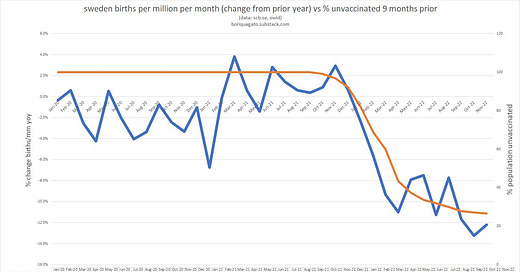


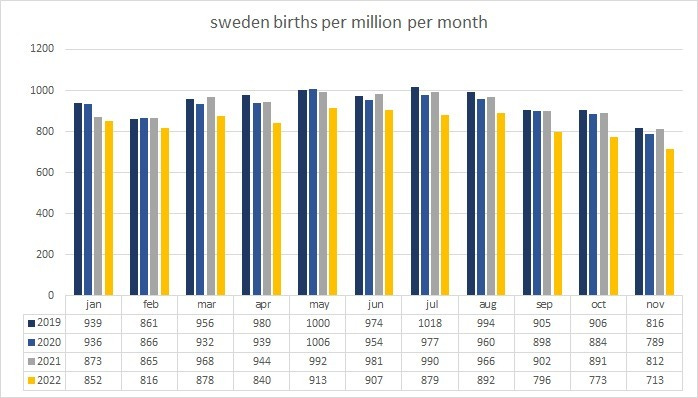
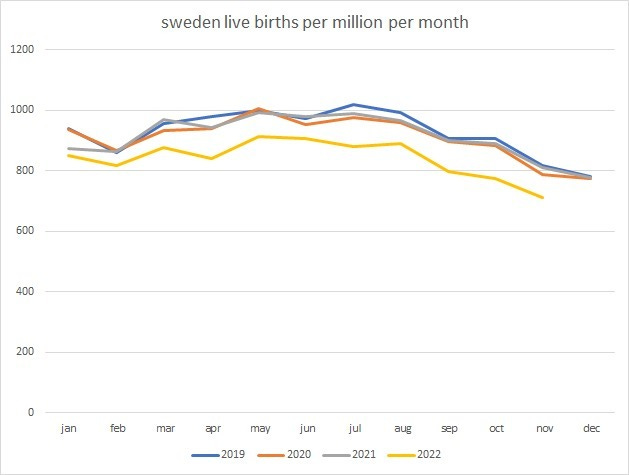
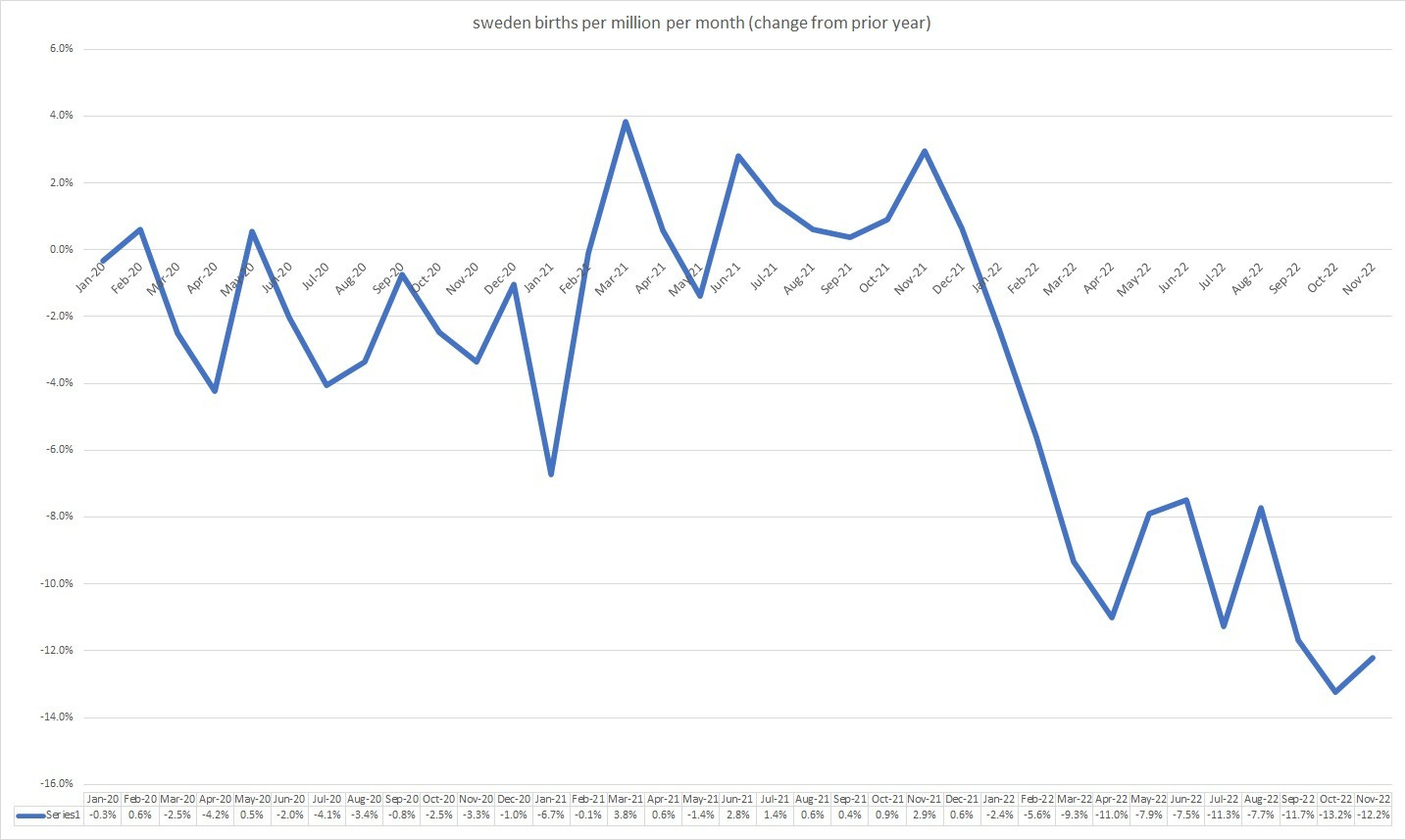

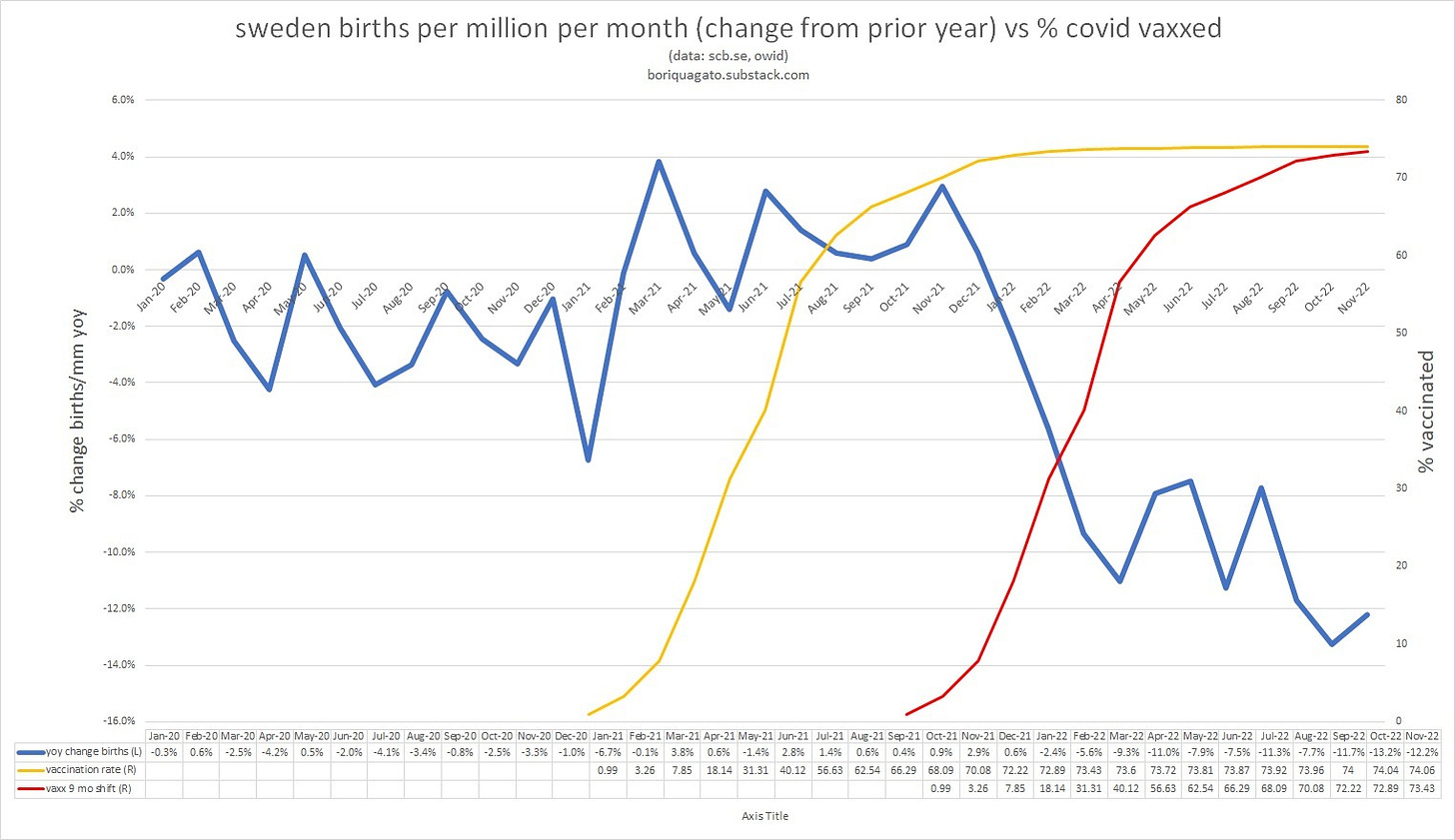













Births for Norway are hard to get. Moody's has births by quarter:
https://www.economy.com/norway/births
The preliminary figures for October and November are 4672 and 3543:
https://fackel.substack.com/p/covid-in-norway-live-births-nosedive
Births for Denmark are here:
https://www.statbank.dk/BEV3A
Among the European countries, Germany and Switzerland are looking like Sweden, whereas for the southern European countries there seems to be some interference with long-term trends:
https://cm27874.substack.com/p/european-births-slideshow
What if this is what they intended all along? Kill off a bunch with the vaccine and cause a significant decrease in births? They wanted depopulation after all. They are getting it.